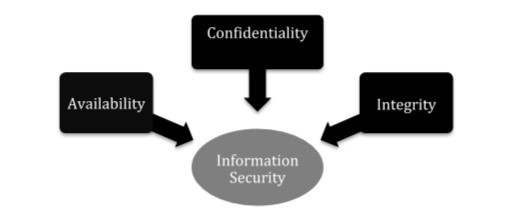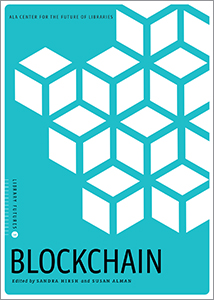Blockchain and the future of libraries: an interview with Sandra Hirsh and Susan Alman
With its high level of transparency and accuracy, blockchain technology is a concept with far-reaching implications for the future of recordkeeping. In the newest volume of the Library Futures Series, Sandra Hirsh and Susan Alman lay out blockchain's challenges and opportunities. We recently had the chance to speak with them about how they originally got interested in the technology and where they see it leading next.
For those who aren’t familiar with the concept, how would you describe blockchain in a few sentences?
The most commonly known use of blockchain is for cryptocurrencies like Bitcoin, however, there are many other uses for this technology. Blockchain is a list of records called “blocks” that are linked together using cryptography, and it’s commonly referred to as a “distributed ledger technology.” It is a  long chain of data entries that are theoretically immutable because cryptography is used to secure data using the hash function. A reference is made each time a block is added to the chain creating a date/timestamp. The high level of transparency makes corruption difficult unless more than 51% of the computing (hashing) power is controlled by one or more groups working together within a blockchain network. There are no intermediaries which allows for self-sovereignty of data and collaboration between users.
long chain of data entries that are theoretically immutable because cryptography is used to secure data using the hash function. A reference is made each time a block is added to the chain creating a date/timestamp. The high level of transparency makes corruption difficult unless more than 51% of the computing (hashing) power is controlled by one or more groups working together within a blockchain network. There are no intermediaries which allows for self-sovereignty of data and collaboration between users.
How did your interest in blockchain lead to the IMLS-funded project at the San José State University School of Information?
The idea of using blockchain for credentials was introduced to us in a presentation at the SXSW Conference in 2016, and we began to explore ideas for its use in libraries. By 2017 it was clear from the expanding literature that blockchain technology was a trend on the brink of revolutionizing the public and private sectors. There were conferences, books, white papers, start-ups, and numerous back-channel discussions on ways blockchain technology could address seemingly endless processes, but librarians had not been evidenced in these mainstream discussions. However, the use of blockchain technology in libraries was on the radar of many information professionals. The Institute of Museum and Library Services (IMLS) awarded us with a $100,000 grant to investigate possible applications of blockchain in libraries. During the past 24 months we have refined ideas on potential use cases for the information professions. These ideas have been honed as we developed the project to include:
- Dedicated website and blog
- Hosted a Blockchain National Forum
- Sponsored a Massive Open Online Course (MOOC), Blockchain & Decentralization for the Information Industries
- Presented findings at numerous national and international professional conferences and webinars
- Publication of our book
You’ve enumerated a number of library-related opportunities for using blockchain as well as several issues and tasks that need to be resolved. What do you think are a few of the greatest opportunities and challenges of this technology as far as libraries are concerned?
The greatest opportunities for libraries at this point are noted in the projects listed below.
IDEA #1 (We submitted a pre-proposal to IMLS for this project.) Societal changes have created groups of people who are away from their residency on a permanent or temporary basis due to homelessness, statelessness, employment (business-related or seasonal work) or travel, and access to information as provided by libraries needs to move with these individuals. People of all ages who are homeless, transient, immigrants, displaced, or away from their usual home base need all types of information resources that include support for literacy, community integration, new skill development, employment services, research, disaster relief, and entertainment. Libraries can provide services to these communities that they cannot obtain anywhere else; however, in most instances these individuals cannot obtain a library card and are ineligible to take materials out of the library. This problem can be resolved through the use of an interoperable blockchain-based system that crosses all types of library systems and a secure verified digital identity that can be used in participating libraries to gain access to information.
Blockchain will be used to provide unencumbered access to digital content and print collections to all potential users in participating library systems while managing risk to ensure that the privacy and personal identity of each user is secure. Sovereign Identity (SSI) is a blockchain application that enables an individual or organization to have sole ownership and control of their digital and analog identities. Information literacy and digital inclusion efforts will be enhanced as users gain access to all resources in those libraries through the creation of their secure and private digital identity.
IDEA #2 Blockchain could be used to develop an international interlibrary loan pilot for the International Federation of Library Association’s (IFLA) voucher system. IFLA provides re-usable vouchers to help libraries easily pay for international interlibrary loan requests. Each voucher represents a standard payment for one transaction. Blockchain would lend itself well to international ILL because of the foreign currency transactions that happen as part of this Interlibrary Loan exchange (blockchain would make foreign financial transactions easier) and due to transactional nature of interlibrary loans generally.
IDEA #3 Blockchain could be used to determine the accuracy and consistency (validity) of data over its lifecycle. This would involve comparing the hash of the original records with a hash recorded on the blockchain. If the two hashes do not match, the records have been altered in some way. We are  discussing a way to set up an individual repository to establish an original document upon ingestion and validate the integrity of data over its life by mimicking migration from one format to another. Records administration is a realistic concern for the information professions.
discussing a way to set up an individual repository to establish an original document upon ingestion and validate the integrity of data over its life by mimicking migration from one format to another. Records administration is a realistic concern for the information professions.
The challenges are having the time and resources to develop use cases that will provide direction to libraries for using blockchain as a mainstream tool. Blockchain is an untested concept in libraries, and there will continue to be skepticism and reluctance to pursue its use until there are credible examples of the ways that blockchain can be used with success for library processes. Other issues impacting the implementation of blockchain involve standards, privacy, and legalities, and each of these is highlighted in the book.
Some experts say blockchain is bad for the environment, pointing to its high energy usage and carbon footprint, while others claim the exact opposite, arguing that blockchain could be sustainable because it would lead to a significant increase in information transparency, efficiency, and accountability. What’s your view and why?
High energy consumption is common for blockchain initiatives such as crypto data mining that you would find in a public ledger spread across thousands of computers. The projects that we’re proposing are low energy use private ledgers or localized public distributed ledgers. Energy consumption is not a concern in these test cases and would only be a factor if libraries used blockchain on a wide-scale basis.
After folks read your book, how can they learn more about where this technology is heading?
We developed a website that is being updated on a regular basis with information for people with all levels of expertise. Articles are identified with a symbol indicating if the resource is for someone with a beginner, intermediate, or expert level of blockchain expertise.
Learn more at the ALA Store.
